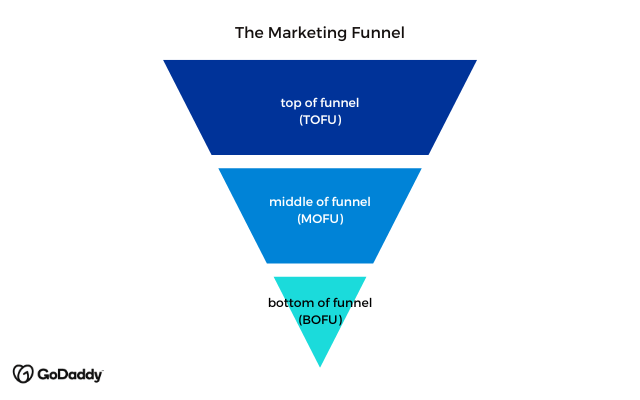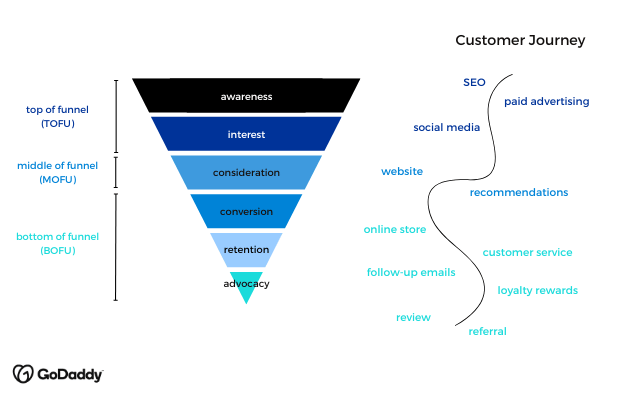Are you a website owner contemplating a domain name change, wondering how to grow your business quickly in Asia’s dynamic markets? With over 4.7 billion people and some of the world’s fastest-growing economies, Asia presents tremendous opportunities for digital entrepreneurs.
This is not your typical "how to grow your business" blog that covers a wide range of general tips.
Instead, this article focuses on the specific strategy of understanding and creating a well-designed marketing funnel to drive growth in Asia. Think of it as a crash course in turning strangers into loyal customers who can't resist buying from you.
Whether you’re targeting Singapore’s tech-savvy consumers, Indonesia’s booming e-commerce scene, or the rising middle class in Vietnam and the Philippines, the region offers diverse pathways to rapid growth. With 69% of consumers across Indonesia, Malaysia, Philippines, Singapore, Thailand, and Vietnam making online purchases in the past 12 months, the best way to expand your business in the new year is to meet them exactly where they’re hanging out - on the world wide web.
However, success in Asia requires more than just translation or a new domain. It demands a localized, data-driven approach that aligns with cultural nuances, digital behaviors, and unique market regulations.
In thisguide, we’ll show you proven strategies to accelerate your business expansion across Asia, from choosing the right domain and localization tactics to leveraging regional platforms and forming powerful partnerships.
Let’s unlock your business potential in Asia!
Understanding Asia’s business landscape
Asia is not a monolith, but a tapestry of cultures, economies, and digital behaviors. The region’s diversity is both a challenge and an opportunity for website owners looking to grow quickly.
Key markets such as Singapore, Malaysia, Philippines, Indonesia, Vietnam, Thailand, Taiwan, and Hong Kong each have distinct consumer preferences, internet penetration rates, and regulatory environments.
Singapore is a global business hub, known for its ease of doing business and high digital adoption. Indonesia boasts a population of over 270 million, with a rapidly expanding middle class and mobile-first population. Vietnam and Thailand are seeing a surge in e-commerce and digital payments, while Hong Kong and Taiwan offer access to affluent, tech-savvy consumers.
Understanding the regional differences in online behavior, payment preferences, and language is the first step. For example, while credit cards are common in Singapore, e-wallets like GoPay and OVO are favored in Indonesia. This means your approach must be market-specific rather than “one size fits all.”
Starting your business from scratch
Creating your business from scratch can seem intimidating. However, you definitely do not want to miss out on jumping on this lucrative emerging market bandwagon. If you’re starving for ideas, look into starting online businesses in Singapore or Philippines. You can also read these step-by-step guides to starting a business in Malaysia or Hong Kong.
And if you’re already a successful business owner, but haven’t taken the leap into the wonderful world of online sales yet, you’re in luck because we’ve got this handy 7-step guide to building a strong brand to help get you there.
Related: How do I start selling online? A beginner’s guide
1. Market research: identifying high-growth opportunities
Research on different country profiles
- Singapore: High GDP per capita, English-speaking, leading in fintech and SaaS adoption.
- Malaysia: Multilingual, strong e-commerce growth, fragmented payment landscape.
- Indonesia: Large, youthful population, rapid mobile adoption, preference for local brands.
- Vietnam, Thailand, Taiwan, Hong Kong: Each has unique regulatory and payment ecosystems.
Analyzing consumer behavior
Conducting thorough market research is the foundation of any successful expansion strategy in Asia. Each country has its own unique profile, consumer behaviors, and market dynamics that must be understood before you invest in localization or a new domain. For example, Singapore stands out with its high GDP per capita, widespread English proficiency, and leadership in fintech and SaaS adoption, making it an attractive market for premium services and innovative tech solutions.
Malaysia, on the other hand, is characterized by its multilingual population, strong e-commerce growth, and a fragmented payment landscape that requires businesses to offer various payment methods to capture the widest possible audience. Indonesia’s large, youthful population and rapid mobile adoption, coupled with a strong preference for local brands, make it a hotbed for mobile-centric business models and localized marketing. Meanwhile, Vietnam, Thailand, Taiwan, and Hong Kong each present their own distinctive regulatory environments and payment ecosystems, requiring tailored strategies to navigate compliance and consumer expectations.
When analyzing Asian consumer behavior, it’s crucial to recognize that over 70% of Southeast Asians use mobile devices as their primary means of accessing the internet. This mobile-first usage has fueled the rise of social commerce, with platforms like WhatsApp, LINE, and Zalo serving as essential channels for customer engagement, brand communication, and even direct sales. Payment preferences also vary widely: while digital wallets and bank transfers are gaining traction, cash on delivery remains a significant choice in Vietnam and the Philippines, especially for first-time online buyers wary of digital transactions.
To effectively identify high-growth opportunities, leverage powerful market research tools such as Google Market Finder, SimilarWeb, and Facebook Audience Insights. These resources can help you analyze demand, competition, and consumer demographics, enabling you to pinpoint where your product or service fits best in the Asian landscape—before you invest heavily in localization or domain changes. By deeply understanding the nuances of each market and analyzing Asian consumer behavior, you can craft a strategy tailored to real-world demand and maximize your chances of success.
2. Tailoring your offer: product-market fit in Asia
Achieving product-market fit in Asia requires more than simply translating your website or adjusting your pricing—it’s about genuinely adapting your product or service to local tastes, needs, and purchasing power. Localizing your content is the first step; offering your website and marketing materials in languages such as Bahasa Indonesia, Thai, Vietnamese, and Chinese not only makes your brand more accessible but also signals respect for the local audience. Beyond language, adapting visuals, messaging, and even user interface elements to reflect regional culture can dramatically increase engagement and conversion rates. For instance, colors, imagery, and even humor that resonate in one Asian market might be ineffective or even off-putting in another.
Feature adaptation is another key aspect of localizing your website for Asia. Consider how platforms like Tokopedia in Indonesia have thrived by integrating “pay later” options—addressing local consumer needs for flexible payment and credit solutions. Similarly, food delivery platforms in Vietnam often partner with local restaurants and offer cash-on-delivery to build trust with new users. When setting your pricing strategy, take into account the local purchasing power, competitive landscape, and the perceived value of your product in each country. Don’t assume that pricing strategies from Western markets will translate seamlessly; what works in Singapore might not work in Indonesia or the Philippines.
A unique and highly effective approach is to run small-scale tests—such as targeted Facebook ads or localized landing page variants—in each market before committing to a full-scale rollout. This allows you to gather real data on user preferences, conversion rates, and customer feedback, enabling you to fine-tune your offering for each audience. By methodically localizing your website for Asia and adapting both features and pricing to local realities, you’ll be far better positioned to achieve viral growth and outpace less agile competitors.
3. Choosing the right domain name for your business in Asia
Why do domain names matter in Asian markets? Choosing the right domain is both a branding and a technical decision. Here are some considerations when you decide on the best domain for Asian markets in your expansion plan.
ccTLDs vs. .com - Localization and trust vs global branding
When choosing a domain name for your business in Asia, you are most likely to be contemplating between using a .com or using a country code TLD (ccTLD).
A localized domain can dramatically improve user trust and brand authority. For many Asian consumers, a country-code TLD (like .sg, .tw, .ph, .vn) signals that a business is locally relevant and compliant with local norms.
However, for large global or regional brands, the .com domain is definitely a valuable asset to ensure alignment in web presence across the world. Therefore, most businesses would adopt a hybrid approach, where they will use .com for their global brand website and ccTLDs for country-specific landing pages.
It is important to note that some Asian countries have strict domain registration requirements. For example, .sg domains require a local entity; .id domains are easier but would still require local documents.
For example, Shopee (shopee.sg, shopee.my) use local domains to build brand trust and signal local presence.
SEO implications vs brand consistency and legal considerations
Search engines in Asia, such as Baidu (China), Naver (South Korea), and Google (most Southeast Asia), often favor local domains and locally hosted sites in search rankings. If you’re changing your domain, ensure you set up proper 301 redirects, inform Google Search Console of any domain changes and update all local business listings to preserve and enhance SEO. This also helps to avoid SEO penalties during migration.
However, if you are a brand looking to expand in Asia, ensure that your new domain doesn’t infringe on local brands. Keep naming conventions uniform for easy recall and consistent branding.
4. Crafting a winning Go-to-Market strategy
a. Learn the marketing funnel
Are you familiar with the digital marketing funnel? If not, you’re not alone. According to Salesforce data, nearly 70% of companies are unaware of how their funnel looks. But not understanding your marketing funnel is a surefire way to waste resources and miss out on potential business growth opportunities.

A marketing funnel is a powerful way of visualizing all of the different stages that customers go through on their journey from first learning about your business to becoming loyal, repeat customers.
It starts with TOFU (top-of-funnel),moves through MOFU (middle-of-funnel), and ends with BOFU (bottom-of-funnel).
- TOFU (top-of-funnel): Potential customers get their first taste of your company. They may see your social media posts or an ad for your product or service online. Your goal is to generate interest by introducing them to your brand and giving them enough information to spark their curiosity.
- MOFU (middle-of-funnel): This stage is mostly nurturing leads until they become qualified sales prospects. You provide more information about who you are and what you do, such as case studies, customer reviews, free trials, etc. It’s important not to push too hard for a sale because people still aren’t ready yet. Most might need more time and information before they make a buying decision.
- BOFU (bottom-of-funnel): This is where leads convert into paying customers. Most businesses use time-sensitive messaging and action-based messaging to convince and convert customers. Strategies like retargeting ads and email marketing come into play.
b. Map out your target customer segment

And we don't mean coming up with something like "people who like pizza". We're talking specifics here, like age, location, income, interests, and pain points. If you discover your customers’ desires and frustrations, you'll be able to offer solutions that they'll actually want. According to CMO Council research, only 26% of marketers in Asia-Pacific admit they don't have a solid plan for engaging customers.
A great way to learn more about your potential customer is to survey them. Using a survey tool like SurveyMonkey, Microsoft Form or Google Form (free to use) allows you to create professional-looking surveys. This can be distributed to your customers via social media, email or on your website.
According to SurveyMonkey, here are the top 5 questions to ask your customers:
- What would you like to see us keep (and/or stop) doing?
- Are you willing to enthusiastically recommend us to a prospect today? If not, where must you see change this week?
- What's the main benefit you receive from our product/service?
- What are your biggest challenges?
- Why did you choose us over the competition? / If you had to choose a competitor who would it be and why?
There are other ways to gather customer insights without conducting sureys. You can start by analyzing both your and competitors' reviews. Through this process, you can identify patterns and common issues to improve your product or service. Pay closer attention to the 'most helpful' reviews, they tend to be informative and actionable, giving a more accurate representation of customer sentiment.
Forums such as Reddit, Quora, as well as blogs and social media are also great channels to do research on customer insights.
What to look out for when you map out target customers?
Here are several key things to look for when scouting for your dream customer:
- Customer demographics: This includes information such as age, gender, income, education level, and occupation, which can help you understand who your target customers are.
- Customer needs and wants: This includes understanding what customers want from your product or service, as well as any pain points or problems they are facing.
- Customer satisfaction: This includes understanding how customers feel about your product or service, as well as any areas that need improvement.
- Competitor analysis: This includes understanding how customers find your competitors, how they perceive them and what your competitors offer that you don't.
- Buying habits and preferences: This includes understanding how customers make purchasing decisions, as well as their preferred purchasing channels.
- Customer loyalty: This includes understanding how likely customers are to continue doing business with you, and why.
- Customer language: This includes understanding the language and terminology that current customers use when discussing your product or service, which can help you develop more effective marketing strategies and messaging.
c. Outline your customer journey, business goals and metrics using the marketing funnel

Mapping out the customer journey allows you to understand steps customers take leading up to a purchase, enabling you to improve your process and grow your business. You can gather inspiration from customer research, such as how they find your competitors' products and services, and use that as a template to outline your own. Once you mapped out the customer journey, think about the actions you want customers to take at each step. This way, you can set goals, measure your progress and make adjustments as needed.
Hdre's an example of a customer journey for an organic skincare company using the TOFU, MOFU, BOFU marketing funnel:
TOFU (Top of the Funnel)
Customer journey
- Awareness: The customer first becomes aware of the brand through social media ads, influencer partnerships, or word of mouth.
- Interest: The customer visits the website to learn more about the products and the brand's mission to use only organic and natural ingredients.
Goals and metrics
- Goal: Increasing website traffic through targeted advertising and search engine optimization.
- Metric: Website traffic and bounce rate
- Goal: Building brand awareness through social media campaigns, influencer marketing and content marketing
- Metric: Social media engagement and follower growth
- Goal: Capturing leads through forms, quizzes, or gated content
- Metric: Lead generation and form submissions
- Goal: Educating prospects about your products or services through thought leadership pieces and webinars
- Metric: Social media engagement (likes, shares, comments)
- Goal: Building a prospect list through events and networking
- Metric: Number of email subscribers or contacts added
MOFU (Middle of the Funnel)
Customer journey
- Consideration: The customer reads reviews and testimonials, watches product demonstration videos, and compares the brand's products to others on the market.
Goals and metrics
- Goal: Nurturing leads and building relationships through personalized email campaigns and drip marketing
- Metric: Open and click-through rates for email campaigns
- Goal: Qualifying leads through surveys and assessments
- Metric: Conversion rates for landing pages and forms
- Goal: Providing valuable content such as case studies, product demos, and testimonials
- Metric: Number of downloads or views of gated content
- Goal: Offering a free trial or consultation to give prospects a taste of your products or services
- Metric: Number of free trials or consultations requested
- Goal: Building trust and credibility through social proof and customer reviews
- Metric: Number of customer reviews or testimonials collected
BOFU (Bottom of the Funnel)
Customer journey
- Conversion: The customer makes a purchase, chooses a subscription plan, or requests a consultation with a skincare specialist.
- Retention: The customer receives follow-up emails with personalized skincare tips and exclusive promotions, and has the option to leave a review and refer friends to the brand.
- Advocacy: The customer becomes a repeat buyer and shares their positive experience with friends and family.
Goals and metric
- Goal: Closing sales and generating revenue
- Metric: Conversion rates and revenue
- Goal: Increasing customer lifetime value through upselling and cross-selling
- Metric: Customer Lifetime Value (CLV)
- Goal: Building brand loyalty and advocacy through excellent customer service
- Metric: Net Promoter Score (NPS)
- Goal: Measuring and improving customer relationships and satisfaction
- Metric: Customer retention rate
- Goal: Optimizing the checkout process to reduce cart abandonment rates
- Metric: Cart abandonment rate
d. Choose the right digital and social media channels

Don't try to be a jack of all platforms and master of none. Focus on building a strong presence on one social media channel before expanding to others. It's easier to manage and understand a single platform's audience and content approach. For example, if your business is in the fashion or home decor niche, Pinterest is a great starting point as it's visually-focused and has a large engaged user base.
When selecting digital and social media channels for your business in Asia, it’s crucial to recognize that user preferences and platform dominance vary significantly across the region. In established markets like Singapore and Malaysia, Google remains the go-to search engine, while Facebook and Instagram are the primary social networks for both brand building and customer engagement, offering robust advertising tools and highly targeted options.
However, in Thailand and Vietnam, the landscape shifts: LINE—a popular messaging app—serves not only as a communication tool but also as a powerful marketing platform, enabling brands to reach users through official accounts, broadcasts, and interactive campaigns. Additionally, TikTok’s explosive growth in these countries has made it essential for reaching younger, trend-driven audiences through short-form video content and influencer collaborations.
Beyond traditional social channels, Asia’s e-commerce boom has fueled the rise of marketplace advertising. Platforms like Shopee, Lazada, and Tokopedia dominate online shopping in Southeast Asia, offering businesses the ability to stand out with paid listings, sponsored products, and banner ads directly within the shopping environment. This integrated approach enables brands to capture consumers at the moment of purchase intent, driving both visibility and conversions.
To succeed, businesses should tailor their digital strategy to each market’s unique preferences, leveraging the right mix of search, social, and marketplace channels for maximum impact.
e. Lean in on influencers and KOL Partnerships
Partnerships are a cornerstone of successful digital marketing in Asia, where trust and authenticity play a pivotal role in consumer decision-making.
In markets such as Indonesia, Thailand, and Vietnam, Key Opinion Leaders (KOLs) are regarded as highly credible voices whose recommendations can significantly sway purchasing decisions—often more so than traditional brand advertisements. These individuals, ranging from celebrities to niche experts, have built dedicated followings who value their opinions on products, services, and lifestyle trends.
Alongside prominent KOLs, micro-influencers—those with smaller but highly engaged audiences—are proving especially effective. They tend to foster closer relationships with their followers, resulting in higher engagement rates and greater trust, all while offering more cost-effective collaboration opportunities for brands.
By strategically partnering with both KOLs and micro-influencers, businesses can localize their messaging, tap into established online communities, and build credibility quickly. This approach is particularly powerful in Asia, where peer reviews and word-of-mouth, especially from familiar or relatable figures, are often prioritized over corporate messaging. To maximize impact, brands should partner with regional KOLs to accelerate trust-building. The focus should remain on influencer strategies that are tailored to each market, ensuring collaborations feel authentic and relevant to local audiences.
5. Localization: language, culture, and UX

If you've done your job right on social media; you've caught the attention of potential customers, building a trove of people who know, like and trust your brand. It's time to move them further along the marketing funnel and speed up the process of turning them into paying customers. One of the best ways to do that is to guide them to your website.
Tips for a high-converting, user-friendly website
For a seamless user experience, focus on streamlining your website's structure and functionality. Think simple navigation, intuitive menus, and prominent call-to-actions. By making it easy for visitors to find what they need, you'll increase the chances of them converting into customers. Check out GoDaddy Studio for stunning user-friendly designs.
Related: The ultimate website functionality checklist
From your homepage to your product descriptions, your copy should be concise and captivating, engaging the reader from the outset. Don’t forget to include keywords where appropriate to ensure SEO optimization.
Related: How to write website copy?
Effective localization is essential for businesses aiming to thrive in Asia’s diverse digital landscape, and it begins with adapting your website to meet the linguistic and cultural expectations of each market. Multilingual sites are a must—offering language options such as Bahasa Indonesia, Thai, Vietnamese, and Traditional Chinese ensures that users can navigate, interact with, and trust your platform.
Ideas on localization: make your website user-friendly for Asian audiences

Beyond language, cultural adaptation plays a crucial role in shaping user experience (UX); this means using colors, visuals, and idioms that are culturally relevant and appealing to local audiences. For example, red is often associated with luck and prosperity in Chinese-speaking regions, while certain imagery or humor may resonate differently across Southeast Asian countries.
Equally important are local payment methods, as preferences vary widely across Asia. Integrating popular e-wallets like GrabPay, OVO, GCash, and Alipay can remove barriers to purchase, while offering bank transfer options—a favored choice in Malaysia and Indonesia—caters to users who may not have credit cards. Additionally, cash on delivery remains a vital payment method in countries like Vietnam and the Philippines, where digital transactions are still gaining traction.
To further enhance user trust and conversion rates, invest in native-speaking customer support and deploy localized chatbots capable of addressing inquiries in the user’s preferred language. This not only creates a seamless support experience but also demonstrates your commitment to serving local customers, ultimately reducing churn and fostering loyalty.
By prioritizing language, cultural nuances, and local payment solutions, businesses can create a user journey that feels genuinely tailored—one of the most effective strategies for building trust and driving growth in Asia.
Editor’s note: Building a website from scratch isn’t just for web developers - GoDaddy’s Website Builder makes it easy with marketing tools designed for business growth strategies.
6. Optimizing for local search engines & social platforms
Optimize your content to make it more visible in search engine results, increase page views and attract more visitors. Applying SEO techniques involves choosing the right keywords, optimizing page titles, meta descriptions and content tags, as well as keeping your content up-to-date and relevant.
Besides that, optimizing your online presence for local search engines and social platforms is critical for gaining visibility and credibility in Asia’s fragmented digital ecosystem. Each market has its own dominant platforms and specific SEO requirements.
For instance, to rank well on Baidu in China, your website must be in Simplified Chinese, hosted on Chinese servers, and possess an ICP license, which signals official government approval. In South Korea, Naver reigns supreme; success here depends on publishing high-quality Korean language content and leveraging Naver Blog integration, as this platform prioritizes its own ecosystem in search results. Meanwhile, in Southeast Asia, Google is the primary search engine, so it’s vital to implement local schema markup, optimize for region-specific keywords, and set up Google My Business profiles for each targeted country, ensuring accurate local listings and higher map visibility.
Beyond search engines, regional social networks are equally important for engaging users and driving social commerce. LINE is indispensable in Thailand and Taiwan, functioning as both a messaging app and a marketing channel through official accounts and in-app promotions. WeChat is crucial for Hong Kong and businesses aiming for cross-border trade with Mainland China, enabling seamless communication, payments, and mini-program integration. Vietnam’s Zalo, with its robust user base, is the go-to platform for direct customer interaction and community building.
As social commerce rapidly expands across Asia, integrating chat-based sales and social checkout options into these platforms can significantly boost conversion rates and customer satisfaction. By mastering Asian SEO best practices and embracing the right mix of local search and social platforms, businesses can effectively reach and convert their target audiences in this highly competitive region. Integrate chat commerce and social checkout options to maximize conversion.
7. Building trust & reputation in Asian markets
Building trust and reputation in Asian markets requires a multi-faceted approach that blends digital credibility with local relevance.
One of the most effective ways to foster trust is by collecting and prominently displaying customer reviews and testimonials, especially from local users. Platforms like Trustpilot, Google Reviews, and popular regional alternatives give prospective customers authentic insights into your product or service, while video testimonials—especially in countries like the Philippines and Indonesia—add a layer of authenticity and personal connection that resonates deeply with local audiences.
Additionally, forging partnerships with trusted local entities can significantly enhance your brand’s reputation. Joint marketing campaigns with well-known local brands or industry associations lend credibility, while obtaining country-specific certifications or quality seals can reassure customers of your legitimacy and compliance with local standards.
Beyond these traditional tactics, consider incorporating region-specific trust signals, such as displaying QR codes for secure bank transfers or actively participating in local business councils and trade groups. These small but impactful steps signal to customers that your business is not only legitimate but also committed to understanding and integrating into their unique market landscape. Ultimately, prioritizing transparency, community engagement, and local validation will help you build a robust, trustworthy reputation in Asia’s diverse and discerning markets.
8. E-commerce and mobile-first strategies
In Asia’s rapidly evolving e-commerce landscape, popular platforms like Shopee, Lazada, Tokopedia, and Tiki play a pivotal role in shaping consumer buying habits and driving business growth. These marketplaces command an overwhelming share of the region’s online retail activity, with more than 70% of Southeast Asian e-commerce transactions taking place on their platforms.
For businesses aiming to capture this audience, seamless integration with marketplace APIs is essential. These integrations allow for real-time inventory synchronization, streamlined order management, and efficient pricing updates—eliminating manual errors and ensuring a smooth customer experience across multiple sales channels.
Equally important is adapting to the region’s mobile commerce trends, as mobile-first business strategies are now the norm in Asia. A significant majority of consumers prefer using dedicated mobile apps over traditional web browsing, attracted by features such as app-exclusive deals, simplified navigation, and faster checkout processes.
Live streaming commerce has emerged as a powerful sales driver, especially in Southeast Asia, Taiwan and Hong Kong, where influencers and sellers host interactive sessions to showcase products and engage directly with buyers in real-time. To maximize engagement and sales, businesses should launch mobile-exclusive promotions and utilize push notifications to entice users back to their apps, encourage repeat purchases, and create a sense of urgency around special deals.
By embracing marketplace dominance and mobile-first strategies, companies can position themselves at the heart of Asia’s vibrant digital economy and foster long-term customer loyalty.
9. Legal compliance & data privacy
Navigating legal compliance in Asia is a critical aspect of sustainable business growth, as the region features a complex web of regulations that can vary dramatically from country to country.
Data protection laws are increasingly stringent, with Singapore’s Personal Data Protection Act (PDPA), Malaysia’s PDPA, and Indonesia’s emerging Personal Data Protection (PDP) Bill all imposing strict requirements on how businesses collect, store, and use personal data. Non-compliance can result in substantial fines and reputational damage, making it essential for companies to implement robust data management and privacy policies tailored to each jurisdiction.
In addition to data privacy, local business regulations may restrict foreign ownership, mandate joint ventures with local partners, or require specific business licenses and approvals for certain industries. These requirements can pose significant barriers to entry and operational continuity if not properly addressed from the outset.
To mitigate these risks and ensure ongoing legal compliance in Asia, it’s vital to engage experienced local legal advisors who understand the nuances of each market’s regulatory landscape. By proactively addressing legal obligations and seeking expert counsel, businesses can avoid costly missteps, build trust with local stakeholders, and lay a strong foundation for long-term success in the region.
10. Scaling operations: logistics & customer support
Scaling operations in Asia requires a robust logistics and customer support framework tailored to the region’s complexity and diversity. Leveraging third-party logistics (3PL) providers such as Ninja Van, J&T Express, and Lalamove enables businesses to efficiently manage deliveries across multiple countries, ensuring timely fulfillment even in remote or densely populated areas. For companies eyeing cross-border expansion, establishing fulfillment centers in strategic regional hubs like Singapore or Hong Kong can streamline inventory management and expedite shipping to various Asian markets.
On the customer service front, offering multilingual, omnichannel support is essential. Popular messaging platforms like WhatsApp, LINE, Facebook Messenger, and Zalo are deeply integrated into daily communication across Asia, making them ideal for delivering real-time assistance and fostering customer loyalty. Incorporating AI-powered chatbots that provide localized, market-specific responses in multiple languages further enhances the support experience, reducing response times and catering to diverse customer preferences. As competition intensifies, fast and reliable shipping becomes a key differentiator—offering features such as real-time order tracking and hassle-free, free returns can significantly boost consumer confidence and satisfaction.
By investing in advanced logistics solutions and responsive, culturally attuned customer support, businesses can scale efficiently and build lasting relationships with Asian consumers.
11. Measuring success: KPIs & analytics

Measuring success in Asia’s diverse business environment requires a data-driven approach that goes beyond tracking generic metrics. To understand your impact and optimize your strategies, focus on key performance indicators (KPIs) such as website traffic growth, conversion rates, customer lifetime value, and local market share in each target country. These metrics provide granular insights into how well your offerings resonate with different audiences and reveal areas for improvement.
To ensure that your marketing efforts are effective, track the results from each stage of your marketing funnel. This allows you to see what strategies work best for your audience and make necessary adjustments over time.
If your business isn't growing as you’d like, start by analyzing the customer journey from the top of the funnel (TOFU). If you're not meeting your metrics such as website traffic or lead generation at the TOFU stage, it may not be necessary to make changes to the bottom of the funnel (BOFU) stages such as your sales page.
Focus on improving the things that affect your metrics, like content and strategies, until you meet your TOFU goals and then move on to analyzing the middle of the funnel (MOFU) and BOFU to identify the "bottlenecks" in the customer journey that are preventing progress.
Leveraging tools like Google Analytics, Baidu Analytics for China, and region-specific CRM solutions can help you collect and analyze data relevant to each market’s unique dynamics. Incorporating regular A/B testing into your strategy is equally important—by experimenting with localized content, pricing, or user experiences, you can identify what drives engagement and conversions in each country.
For optimal results, set up country-specific dashboards that consolidate your most important metrics, enabling your team to monitor performance at a glance and swiftly pivot strategies in response to new trends or challenges. This localized, agile approach to measuring business growth in Asia ensures you stay ahead of the competition, make informed decisions, and continually refine your expansion efforts for maximum impact.
Case Studies: rapid business growth in Asia
Examining real-world case studies highlights how rapid business growth in Asia hinges on local adaptation, strategic innovation, and a customer-centric mindset. Shopee, for example, became a dominant force in Southeast Asian e-commerce by launching aggressive marketing campaigns, implementing localized payment solutions tailored to each country, and offering compelling seller incentives. Their ability to adapt quickly to market trends—such as introducing mobile-first shopping features and region-specific promotions—helped them outpace both global and regional competitors.
Similarly, Grab’s journey from a simple ride-hailing app to a multifaceted super app exemplifies the power of diversification and deep market understanding. By expanding its service portfolio to include digital payments, food delivery, logistics, and financial services, Grab capitalized on the region’s growing demand for convenience and integrated digital solutions. This relentless expansion was supported by a keen focus on partnerships with local businesses and governments, as well as the seamless integration of local languages and payment methods.
Another compelling example is Glints, a Singapore-based career platform, which achieved impressive growth across Southeast Asia by localizing its job portals and forming strategic partnerships with educational institutions and industry associations. By understanding the unique employment landscapes and talent needs of each country, Glints was able to tailor its offerings, connect job seekers and employers more effectively, and build a trusted brand in diverse markets.
The underlying theme in these success stories is clear: agile adaptation to local preferences, continuous innovation, and an unwavering focus on delivering a superior user experience are the keys to thriving in Asia’s fast-paced markets. Businesses that proactively listen to user feedback and adjust their strategies accordingly are best positioned for sustainable, rapid growth.
Common pitfalls of expanding your business in Asia and how to avoid them
xpanding into Asia’s vast and diverse markets presents enormous opportunities, but it also comes with common pitfalls that can hinder or even derail your growth if not proactively addressed. One of the most frequent mistakes is ignoring cultural differences—overlooking local customs, communication styles, or even color symbolism can result in marketing campaigns that fail to resonate or, worse, offend potential customers. This cultural disconnect often leads to poor conversion rates and wasted advertising budgets. Another major challenge is underestimating regulatory hurdles. Each Asian country has its own complex set of legal requirements, from business licensing and data privacy to foreign ownership rules and local content mandates. Failing to thoroughly research and plan for these regulations can cause costly delays or force businesses to halt their operations altogether.
Additionally, slow website performance is a critical issue in the region, where users expect quick, seamless digital experiences. Websites that load slowly due to inadequate hosting or lack of local optimization not only frustrate visitors but also suffer in search engine rankings, undermining both trust and discoverability. To mitigate these risks, it’s essential to pilot your approach in a single target market before scaling region-wide. This allows you to test localization strategies, identify unforeseen barriers, and adapt based on real user feedback. Continually engaging with local customers and iterating on your offering ensures you remain relevant and competitive, setting a solid foundation for sustainable growth across Asia.
Further strategies to expand your business
Once your business attains a stable customer base, here are two other strategies that you can look into to expand your business.
1. Increase the frequency of repeat business
If a business already has a stable customer base, repeat customers are the way to go. A local restaurant could use email marketing to send out weekly specials to regular customers and encouraging more frequent visits. Loyalty programs also work like a charm here.
2. Increase the value per transaction
Another way to increase profits is by using tactics like bundles with new products and package deals to increase the average sale amount. Explore offering higher-end products too. Almost any activity you can think to grow your business can fall under one of the three categories, including:
- Building relationships with partners. Helps a business get more customers by acting as referral sources, providing insights into customer needs, offering access to new distribution channels and resources, and providing credibility and trust.
- Investing in technology. Brings repeat business by improving efficiency, customer experience, product/service quality, communication and engagement with customers using automation and personalization.
- Building relationships with suppliers. Increases transactional profit and improves cash flow through better pricing and discounts on products or services.
Your roadmap to rapid business growth in Asia
Expanding your business in Asia is one of the most rewarding—and challenging—ventures for website owners, especially when changing your domain name to better capture local audiences. By embracing market-specific strategies, optimizing your website and domain structure, and localizing every aspect of your offer, you position your business for rapid and sustainable growth.
Remember, the Asian market rewards those who adapt quickly and authentically. Invest in market research, build trust through localized branding and partnerships, and use data to steer your expansion. Whether you’re a startup or an established business, the right digital presence and a deep understanding of local needs can transform your growth trajectory.
Ready to grow your business quickly in Asia? Start with a strategic domain name and a commitment to localization, and you’ll be well on your way to success in this vibrant region.
This article was first published on Mar 28, 2023 and updated on Mar 5, 2024 and Jun 24, 2025.









